While admiring your favorite jewelry pieces, have you ever spotted a tiny row of intricate symbols stamped into the metalwork? This is a hallmark, and whenever you buy anything that’s been crafted from precious metal in the UK, it is legally required to be hallmarked. But when and why did the need for hallmarking first arise, and what do the symbols mean? Let’s take a closer look.
A BRIEF HISTORY OF HALLMARKING
Hallmarking is one of the oldest forms of consumer protection in history, and it has been part of the precious metal industry in the UK for over 700 years. It was formally introduced in the year 1300 with the passing of a statute by King Edward I of England, which set forth the requirement of a stamp or ‘mark’ to be made on all pieces of silver, though this was later extended to include gold too. It was a necessary introduction for two reasons. Firstly, it significantly cut down on fraud, as it stopped dishonest traders from mixing their gold and silver with more common and inexpensive metals and selling the resulting wares as pure. Secondly, it protected honest traders from unfair competition. Before the change, consumers of the day would have had little way of knowing whether or not they were buying the real thing.
After the passing of the statute, silver had to meet a standard of 92.5% purity (now known as sterling silver) and gold had to be at least 83.4% pure, which is 20 karat. Workers known as ‘guardians of the craft’, who were initially chosen by the mayor of London, would visit the silver and goldsmiths of the city, test the purity of the metalwork, and if it met the standard the piece would be stamped with a leopard’s head mark. This was the first ever hallmark, and would later become the fineness mark numeral that is still in use today.
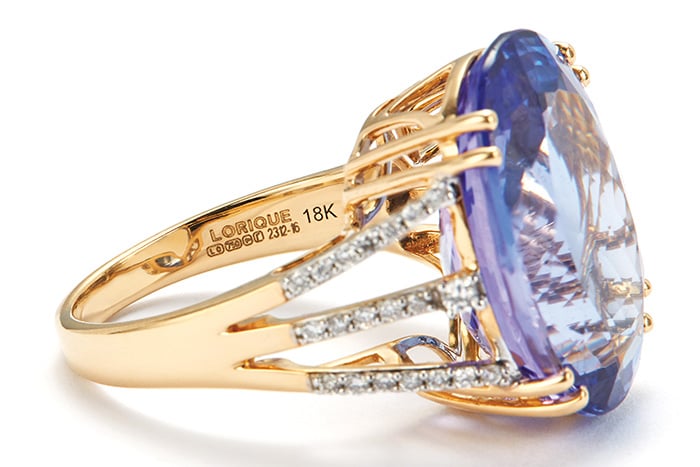
As the practice continued to grow, responsibility for marking items passed to the Goldsmiths' Guild of London, who were based at Goldsmiths' Hall. The guild was responsible for regulating the trade of goldsmiths and silversmiths. Eventually, rather than going out to the individual workshops to mark precious metalware, it became the responsibility of the maker to take their wares to Goldsmiths' Hall for testing. This change in practice ultimately gave us the word hallmarking, meaning the ‘mark of the hall’.
At this point, the hallmark was still just a leopard’s head. In 1363, a second mark was added called the ‘maker’s mark’, which was an identifier for the person who made the piece. If any gold or silver was found to be below the required standard, the maker could then be traced through their mark, records of which were kept at Goldsmiths' Hall, and punished for their deception.
By the 1420s, London’s monopoly on hallmarking was over and there were several other assay offices operating in England. This led to the introduction of a third mark, known as the ‘town mark’, so it was possible to trace a piece back to where it was tested and stamped. London inherited the leopard’s head as its ‘town mark’, which remains in use to this day. From 1457 there was an assay office in Edinburgh providing the same service for Scottish gold and silversmiths and in 1478 a fourth mark, the 'date letter', was introduced as a way of marking each piece with the year in which it had been hallmarked. These four symbols would be compulsory on every single hallmarked item for over 500 years until the date letter became optional in 1998.
CHANGING PURITY STANDARDS
- 1575 Gold standard raised to 91.6% (22 karat)
- 1697 Silver standard raised to 95.8% (Britannia silver)
- 1720 Sterling silver (92.5%) reinstated alongside Britannia silver
- 1798 Gold standard lowered to 75% (18 karat)
- 1854 Gold standards of 37.5% (9 karat), 50% (12 karat) and 62.5% (15 karat) are introduced, though 18 karat and 22 karat remain in use
- 1932 Gold standard of 58.5% (14 karat) replaces 12k and 15k
- 1975 Platinum added to hallmarked metals in purities of 85%, 90%, 95% and 99.9%
- 2010 Palladium added to hallmarked metals in purities of 50%, 95% and 99.9%
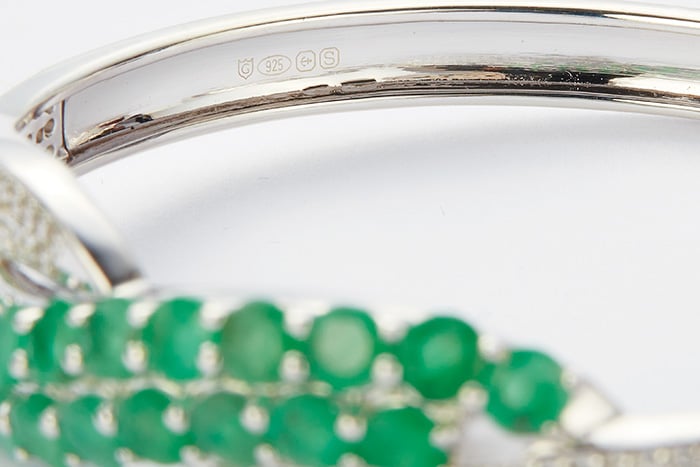
HALLMARKING IN BIRMINGHAM
There are four assay offices still operating in the UK, located in Birmingham, Sheffield, Edinburgh and London. The word ‘assay’ itself is thought to come from the Old French word ‘essai’ meaning ‘trial’.
Each assay office has a distinct mark, the aforementioned ‘town mark’, that makes up part of the hallmark itself. The one you’ll see on Gemporia pieces is the anchor, as our jewelry is hallmarked by the Birmingham Assay Office. How the anchor came to be associated with a landlocked city is believed to be down to how the office was initially founded back in 1773. At the time, many jewelrs and silversmiths in the area were limited to having their work hallmarked in one of the two nearest assay offices of the day, London or Chester (which closed in 1962), both a significant distance away.
Industrial Revolution pioneer Matthew Boulton didn’t like the bottleneck this long journey caused his Birmingham business and was concerned that his designs could be copied. After joining forces with other Birmingham businesses and disgruntled workers in Sheffield too, who were experiencing the same problem, the contingent petitioned parliament on the issue. Despite opposition from other assay offices the two cities were successful, and were permitted to found their own hallmarking centers. The legend goes that just before the two new offices were established, both parties met at the Crown and Anchor pub on the Strand in London to decide how to proceed. When it came to picking their defining marks, they were inspired by the name of the tavern and flipped a coin to decide who got the crown and who got the anchor. Sheffield won the toss and picked the crown (which they later changed to the White Rose of York in 1977) and Birmingham therefore took the anchor.
As well as Chester, there have also been assay offices in Exeter, Glasgow, Newcastle, Norwich and York at various points in time. Items hallmarked in any of these defunct assay offices can see their value go up as serious collectors look to get hold of these rare hallmarks.
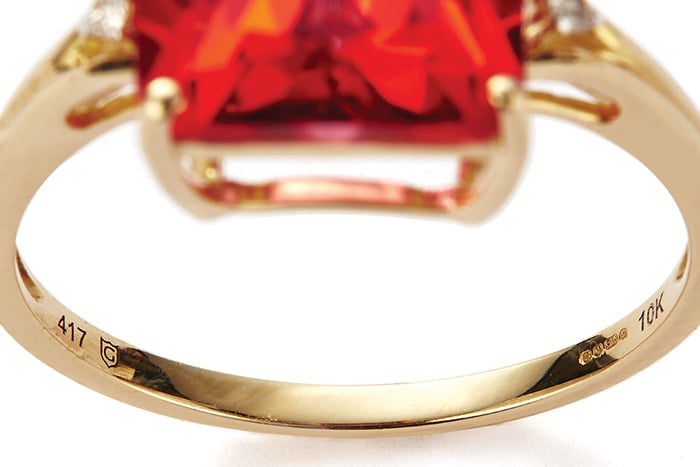
WHERE CAN I FIND MY HALLMARK?
Firstly you’ll need a 10x jewelry loupe or a good magnifying glass so you can get a closer look at your jewelry. On rings the hallmark will usually be on the shank of the ring. On earrings it can depend on the design but if it’s not on the back of the metalwork check the posts as sometimes this is the only practical place to stamp. Bracelets and necklaces often have their stamps on, or very near, the clasp. Pendants usually have theirs on the rear of the metalwork. Remember that pieces below a certain weight aren’t hallmarked. Silver, in particular, needs to weigh 7.78 grams or more to be stamped.
WHAT MAKES UP A HALLMARK?
In the modern age, there are minimum weights at which hallmarking becomes a legal requirement. All gold and palladium items weighing 1 gram or above, platinum weighing 0.5 grams or above and silver weighing 7.78 grams or above must be hallmarked by law. Anything under these weights is exempt and won’t feature a hallmark.
Three compulsory symbols must be present on the hallmark. They are the sponsor’s mark, the fineness mark and the assay office mark.
1. THE SPONSOR'S MARK

This is the mark of the company that manufactured the piece. In the case of jewelry you receive from us, our most recent pieces feature the Gemporia ‘G’ inside a shield. Historically we’ve also used the initials GTV (for Gems TV) and TGGC (for The Genuine Gemstone Company).
2. THE FINENESS MARK
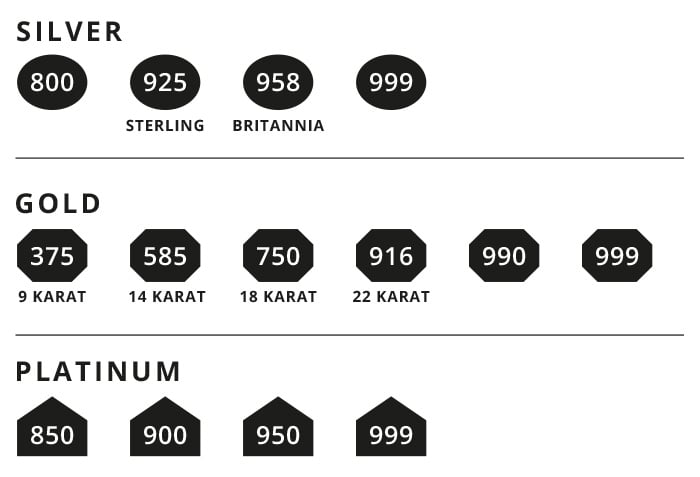
This tells you how pure the metal is, and is shown in parts per thousand. For example, sterling silver is 925 parts pure silver per 1000 parts (the remaining parts being made up of an alloy to strengthen the metal). For the highest purity, the mark 999 is used rather than 1000 because it’s virtually impossible to remove every last trace of impurity.
3. THE ASSAY OFFICE TOWN MARK

This mark tells you the assay office that marked the piece.
Until 1998 it was also a legal requirement to have a date letter stamped on the piece, but the tradition continues as an optional extra mark that Gemporia is only too happy to use.
4. THE OPTIONAL DATE LATTER

Date letters run from A to Z, with a change in typeface and sometimes case every time the alphabet resets. Sometimes, the 'i' or the 'j' is skipped as they’re so similar and occur back-to-back. Since the year 2000, the date letter has been a simple lowercase font inside an octagon shape. We first started selling jewelry in 2004, meaning our first pieces were hallmarked with an 'e', and this year (2018) we’re up to 't'. The next time we skip back to 'a' will be in 2025.
Date letter designs were only standardized in more recent times so if you’re trying to date an antique, make sure to research the specific date letter designs of the assay office that marked the piece.
CARAT OR KARAT - WHAT'S THE DIFFERENCE?
Traditionally, the word ‘carat’ has been used to describe both the weight of a gemstone, such as ‘1 carat Diamond’ and also the purity of gold, such as ‘24 carat gold’. To differentiate the two, Gemporia has always used the alternate ‘karat’ with a ‘k’ for gold purity, which is why you’ll see our gold jewelry listed as 9K, 14K and 18K in their descriptions.
OTHER STAMPS FOUND ON GEMPORIA JEWELRY
With the pieces you get from us, even when items fall below the required weight, you’ll still find the Gemporia ‘G’ stamp and a mark of the metal purity, such as ‘925’ on silver jewelry or ‘10K’ on gold, as long as there’s room to stamp the jewelry without damaging it. You’ll find this on every piece, even if it’s also hallmarked. If you buy one of our exquisite Lorique Collection pieces it will also be marked with the Lorique name and a unique number telling you the design number and year of creation. For example, in the picture on the opening spread of this feature, the number 2312-16 tells you it was the 2,312th piece we made in 2016. You’ll also notice the ‘maker’s mark’ is ‘LQ’ on these pieces.
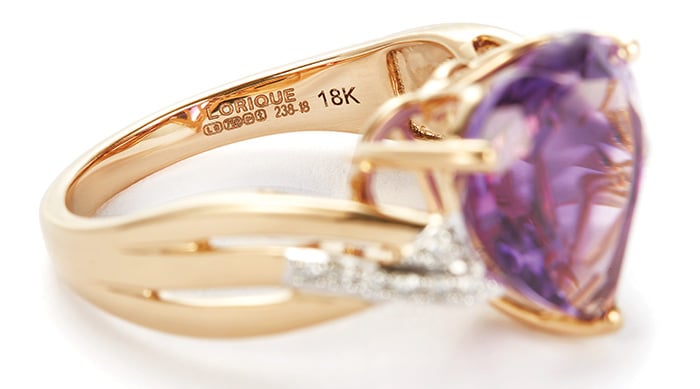
HALLMARKING TODAY
The peak year for hallmarking items was 2003 when 34.7 million items were stamped by the four UK assay offices. This had dropped to 9.7 million in 2016 largely because the price of gold shot up incredibly quickly.
Gold cost nearly six times more to buy in 2010 than it did in 2000, and silver went up almost tenfold in the same period. Fashion has also favored silver in recent years which only requires a hallmark when weighing over 7.78 grams, meaning many pieces didn’t need to go to assay. The recent recession hasn’t helped either.
Despite this nationwide decline of over 70%, assay offices have continued to innovate and adapt. London and Edinburgh now have sub-offices at Heathrow Airport to get new items stamped as soon as they get to the UK. Birmingham went one further in 2016 and opened a sub-office in Mumbai, India, one of the world’s biggest jewelry making hubs. Birmingham also has a gem grading lab and jewelry valuation division, and the assay office here moved to state-of-the-art new premises in 2015.
It may be 718 years since the practice formally began, but hallmarking is as important as ever. Whether you’d ever noticed these tiny symbols or not, they’ve been protecting us against fake goods and fraud for generations. One day, the piece you bought most recently will be an antique, and these four little marks will tell an important part of the story of your piece.
NINE KARAT OR TEN KARAT?
If you’ve ever seen a 10K stamp on your 9K gold ring and wondered why, it's because we sell our jewelry globally. To meet the purity specifications of other countries we make a lot of our gold jewelry at 10 karat (41.7%) purity. There’s no specification for 10K jewelry in the UK, so the nearest legal hallmark it can be given is for 9K. It’s less expensive to do this than to make each design twice in different purities, so we make everything in 10K and pass the saving on to you.
Click here to see the very latest designs we've added to the website and find a beautiful treasure to call your own.

